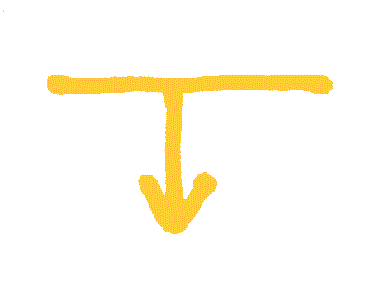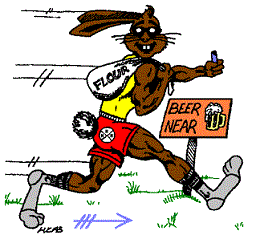In keeping with the original intentions of the Hash, there should be no rules as such. The following however, is a guide that accommodates an accent on healthy exercise whilst discouraging any sense of “athleticism or competitiveness". Each Hash has its own trail laying conventions and the following is a result of experience and advice of members originally from many other Hashes.
Beginning at the beginning, there are one or two little “niceties” which must be observed. When bringing a guest you should ensure that he/she is introduced to the committee and particularly the Grand Master/Mistress BEFORE the run commences. Thereafter it is your responsibitity to ensure that the guest/newcomer completes the run without mishap.
When taking on the responsibility of being a “hare* - and make no mistake it is a responsibility - you should recce your proposed trail at least twice and be certain of every detail before the date of the run. One of these recces should be at about the time of day during which the actual run will take place. The length of trail will vary considerably (generally between 6 and 10 kms) depending largely on the type of terrain over which the trail is laid. As a faily rough guide, if it takes two hours to walk the final trail, than it should be an hour run for the average hasher. An ideal trail keeps everybody together for most of the run and the whole pack should be back to the beer within no more than fifteen minutes of one another, with your slower runners being back in not much longer than one hour from the starting time. To overcome unforeseen difficulties and to ensure a run takes place, it is wise to enlist the aid of a co-hare.
Now to the actual laying of the trail. The following points should be adhered to whenever possible:
⦁ The trail can be marked with a number of different materials, chalk, four, lime. finely shredded paper and off-cuts of gyprock. (The last is a good marker on pavement.) The flour and lime trail markers are usually a BLOB while the chalk and gyprock marks are usually arrows. Arrows show the direction, blobs do not. The trail should be clearly marked at all points and should be uncomplicated for about the first kilometre at which paint you should lay your first check. This check should be a good one, designed to hold the pack for as long as possible in order that late comers can catch up. in addition to the first check an initial loop can help in this regard. At the check it is optional as to whether you write the word "check" in bold letters, inscnbe a large circle, or a combination of both when using chalk. When using flour enscribe a circle.
⦁ Remember your checks are designed to hold up the pack until all members of the run have reached that point before starting off on the next leg. In order to achieve this you may lay false trails from each checkpoint and an indication of possible trails can be shown if you wish. It is important to remember, however, that any trail, correct or False, should start within 100 metres in open country or on roads. 70 metres in semi-scrub, and 30 metres in thick scrub or at night. Three arrows and/or blobs
of flour indicate that the particular trail is most definitely "ON". A false trail from a check can be marked across the trail although this is optional. The main thing to remember is that no false trail should have more that TWO trail markers, as
three markers denotes "ON ON".
⦁ A good run should have at least six checks. If these checks are laid within the above code, then there should be no need to write "ON ON" although it is a good idea if only to jog the minds of the hounds thal they should he calling this once they have found the correct trail. If another Hash has run in ihe same area recently it is advisable to indicate NBH3 beside the occasional arrow or use a different colour marking to that used by the other Hash.
⦁ When laying the trail each marker should not be more than 25 metres fram the last and preferably closer in rough or scrub country. This should be adhered to as closely as possible in order that the hounds can be fairly certain when they have run out of trail. It is quite legitimate to make a sudden left or right turn from a comparatively straight trail without indicating such and the hounds should realise they have over-run the trail when the last mark was some 35 metres or more back. Remember arrows show direction of traits, blobs do not. only that the trail is "ON". The only time that it is essential to write "false trail or indicate the same by a mark across the trail, is when you are worried that continuing in that direction may take the hounds onto another leg of your trail thus cutting out some of the run.
⦁ If the last check has turned the pack onto a long, narrow path over which it is difficult to pass, or a steep, shiggy climb then your next check at the end of this section should be an especially good one designed to hold up the front runners until those who were doing the greatest amount of checking, and who missed the correct trail, have time to catch up again. Remember - at least six good checks which bring the whole pack back together during the run.
⦁ Each trail should, subject to weather and time of year, include a little of everything - a little shiggy, open country, a little bush, and level paths. It should also include a hill, but it should not include every hill within a six kilometre radius. One good hill is quite sufficient. Any fool can knacker the hounds by taking them up every hill in sight, but it takes good recceing to include one good hill only; we are not a mountain climbing club any more than we are a running club. Main roads should be avoided at all times and no checks should be laid on or even close to a busy intersection. Quite apart from the obvious dangers of having the pack milling about the middle of a road there is the problem of hearing the pack Calling over the traffic noise.
⦁ The last check on the run again should be a particularly good one bringing the pack together for ideally a good flat or down hill run-in over a distance of about a kilometre thus giving everybody a chance to stretch their legs. You may, if you wish, on the last sector of the run indicate "ON HOME" which means that each hound is now free to make his/her own way over whichever route is felt to be quickest to the beer, but for the benefit of those who are not familiar with the particular area you must maintain a correct trail to the ON ON site.
Winter runs require special attention and care; the trail must be clear and conspicuous:
1. recce and/or set your run at 6:00pm
2. minimal, if any rocky or precipitous terrain
3. run length shorter than summer (35-50 min)
4. good hot hash mash
5. a site where we can have a good fire to keep warm?
After the run the hares are responsible for checking that all the hounds have returned. If any are still missing one hour after the others have returned the hare must organise search parties. Hares will also be responsible for ensuring that the area has been cleaned up prior to leaving.
Remember trails, checks and false trails should all be designed to hold the pack together in a social run, NOT to create confusion and have hounds milling around for prolonged periods or strung out unnecessarily. Finally to all hounds, the hares will have taken considerable time and trouble to ensure that your run will be as enjoyable as possible. Do not spoil it by acting in an unhash-like manner while running. (Short cutting however is an honourable activity although hares can lay trails in anticipation of this.} The calling by the hounds is important, and if necessary one should return along the trail until the next hound has been contacted. Although it is not mandatory,it is suggested that the hound who picks up the trail after a check should retum towards that check and ensure that the rest of the pack is also "ON". You should call each mark once you have established you are in fact "ON". On hearing "ARE YOU(ON)?" give the appropriate reply i.e.
"ON ON" When you are definitely ON.
"ON HOME" after the ON HOME or ON IN marker.
"CHECKING" after a check (not "looking").
"CHECK BACK" when you've been led up a FALSE trail.
"LOOKING" when you have lost tral (not after a check).
At the ON ON after the run give due regard to the Grand Master and/or Religious Adviser et. al. particularly when run descriptions, down downs, introduction of new prints or mention of following events are being made The "RA" has ways of making you "Listen Up You Wankers"
Good Hashing
ON ON






